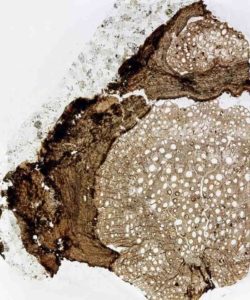
An 18.5 million-year-old fossil found in Panama provides evidence of a new species and is the oldest reliable example of a climbing woody vine known as a liana from the soapberry family. The discovery sheds light on the evolution of climbing plants.
The new species, named Ampelorhiza heteroxylon, belongs to a diverse group of tropical lianas called Paullinieae, within the soapberry family (Sapindaceae). More than 475 species of Paullinieae live in the tropics today.
Researchers identified the species from fossilized roots that revealed features known to be unique to the wood of modern climbing vines, adaptations that allow them to twist, grow and climb.
The study, “Climbing Since the Early Miocene: The Fossil Record of Paullinieae (Sapindaceae),” was published April 7 in the journal PLOS ONE.
“This is evidence that lianas have been creating unusual wood, even in their roots, as far back as 18 million years ago,” said wood anatomist Joyce Chery ’13, assistant research professor in the School of Integrative Plant Science, Plant Biology Section, in the College of Agriculture and Life Sciences, and a corresponding author of the paper.
“Before this discovery, we knew almost nothing about when or where these lianas evolved or how rapidly they diversified,” said first author Nathan Jud, assistant professor of plant biology at William Jewell College and a former Cornell postdoctoral researcher.
Panama was a peninsula 18.5 to 19 million years ago, a volcanic landscape covered with tropical forest in North America and separated from South America by a Central American seaway. While these forests contained North American animals, the plants mostly descended from South American tropical plants that had dispersed across the seaway, Jud said.
“The fossil we described is the oldest macrofossil of these vines,” he said, “and they were among the plants that made it to North America long before the Great American Biotic Interchange when large animals moved between the continents some 3 million years ago.”
In the study, the researchers made thin slices of the fossil, examined the arrangements and dimensions of tissues and water conducting vessels under a microscope and created a database of all the features. They then studied the literature to see how these features matched up with the living and fossil records of plants.
“We were able to say, it really does look like it’s a fossil from the Paullinieae group, given the anatomical characteristics that are similar to species that live today,” Chery said.
During their analyses, the researchers identified features that are characteristic of lianas. Most trees and shrubs have water-conducting tissues (which transport water and minerals from roots to leaves) that are all roughly the same size when viewed in a cross-section; in vines, these conduits come in two sizes, big and small, which is exactly what the researchers discovered in the fossil.
“This is a feature that is pretty specific to vines across all sorts of families,” Chery said.
The two vessel sizes provide insurance for a twisting and curving plant, as large vessels provide ample water flow, but are also vulnerable to collapse and develop cavities that disrupt flow. The series of smaller vessels offers a less vulnerable backup water transport system, Chery said.
Also, cross-sections of the wood in trees and shrubs are circular, but in the fossil, and in many living vines, such cross-sections are instead irregular and lobed.
Thirdly, on the walls of those vascular vessels, they found long horizontal perforations that allow for water to flow in lateral directions. That is a distinguishing feature of lianas in the soapberry family, Chery said.
In future work, now that they can place the lianas of Sapindaceae to 18.5 million years ago, the researchers intend to continue their investigation of the evolutionary history and diversification of this family. Chery also plans to investigate how wood has evolved in this group of vines, including identifying the genes that contribute to lobe-shaped stems.
The study was partly funded by the National Science Foundation.
Reference:
Nathan A. Jud, Sarah E. Allen, Chris W. Nelson, Carolina L. Bastos, Joyce G. Chery. Climbing since the early Miocene: The fossil record of Paullinieae (Sapindaceae). PLOS ONE, 2021; 16 (4): e0248369 DOI: 10.1371/journal.pone.0248369
Note: The above post is reprinted from materials provided by Cornell University. Original written by Krishna Ramanujan.










